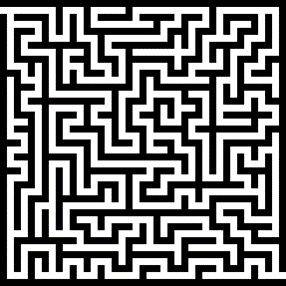Inversion: The Power of Thinking Backwards
When I get bored sitting through a long lecture, I like to draw mazes. And in my many years of sitting through boring lectures and trying to make my mazes better, I have noticed something: many mazes are easier to solve if you start at the end and go to the beginning. Once you have a path that connects the end to the beginning, you can just reverse it, and your maze is solved! Recognizing that you are allowed to go backwards doubles the number of angles of attack at your disposal and makes the problem more solvable. I want to convince you that this skill is generalizable and can extend to any sort of problem.
The idea of solving a maze backwards is an example of what I consider the most powerful thinking technique out there: inversion. Inversion means flipping the problem on its head; you look at the opposite of the problem you actually want to solve, and then you use the insights you gain to help answer the original question.
A maze like the ones I used to draw [1]. Mazes are often easier if you solve them in reverse, starting at the end and going to the beginning.
Here are three examples of how I have used inversion in my personal life.
The other day I was skimming journal articles for my graduate research. When I tried to think of a way to go faster, my brain drew a blank. So I inverted the problem and asked “how could I make this process slower?” That had an easy answer: Be disorganized, fail to take good notes, and lose track of which papers I’d read. That answer convinced me to be more organized and take better notes, which saved me a bunch of time in the end.
I often try to answer the question “how can I be a better thinker and problem solver?” But I’m starting to get diminishing returns when I try to answer that question directly. So, as I was thinking about writing this article, I instead asked myself “how can I make my thinking and problem solving worse?” The answer I immediately came up with was "keep all your ideas to yourself and never seek feedback". That convinced me to seek feedback more often.
While writing this article, I asked myself “what could I do to write an awful article that no one would want to read?” The answers: be boring, offensive, sloppy, and unoriginal. So, as I was revising, I made an extra effort to be interesting, polite, orderly, and novel.
Inverting my thinking has helped me challenge the status quo, think outside the box, and overcome my personal biases and blind spots.
Get really good at avoiding failure
Inverted thinking is powerful because, in many areas of life, success is overrated. What really matters is avoiding failure. This viewpoint was expressed by Charlie Munger (the business partner of Warren Buffet) who passed in November of 2023. He said, “It is remarkable how much long-term advantage [we] have gotten by trying to be consistently not stupid, instead of trying to be very intelligent.” He believed that much of his success came from avoiding unnecessary risks and preventing mistakes rather than any particular genius on his part. He also said that “A lot of success in life and business comes from knowing what you want to avoid: early death, a bad marriage, etc.” If you know what kinds of things would make you miserable, then the key to happiness is making sure they never happen [2].
A picture of Charlie Munger with a plate of cookies [3].
I inverted the colors to pay homage to his love of inverting questions to gain a new perspective.
Munger’s advice is particularly applicable in his field of professional investing because that field is considered a “loser’s game” [4], meaning that you make more progress by avoiding mistakes instead of by making brilliant moves. Other activities that share this characteristic are amateur tennis, amateur chess, and many other areas where players are considered amateurs. In each of these areas, the most valuable use of your time is preventing or correcting your mistakes. I think that many people could do better in life if they accept that they are still amateurs. Even after you’ve gone to four years of college studying engineering, that does not immediately make you an expert on solving new engineering problems. For much of your life, you start out every new project as an amateur. Once you accept that, the next step is to learn to play like one, which means focusing on avoiding blunders. By inverting your thinking in this way, you will find that each poor decision you don’t make adds up. And if you avoid losing for long enough, then eventually you will be successful!
Inversion in engineering design
The idea of inversion has inspired several techniques that can be useful for engineering design. I am going to talk about two of them: reverse brainstorming and pre-mortems.
Reverse brainstorming is a valuable technique for reframing the problem [5]. Ask yourself some of the following questions:
How could I make this product unreliable and fail constantly?
How could I make this even more complex?
How could I increase costs?
How could I make this more harmful to the environment?
How could I make this unsafe?
Take the answers to those questions, then reverse them, and see if they make sense. Sometimes these questions will reveal a failure mode that you hadn’t thought of, or give you a new insight into which problems you really need to solve.
Another inversion technique, sometimes used in project management, is called a ‘pre-mortem”. You tell your team, “three years from now, in an alternate future, our project fails miserably. What are the factors that led to this failure?” Then you discuss how such a failure could have happened. Such a discussion allows your team to identify potential problems before they arise and be proactive in addressing them. Framing the problem in this way has the following advantages:
It helps you see things more objectively and counteract your personal biases.
It encourages teammates to bring up ideas that they may have been hesitant to raise.
It reveals hidden assumptions you didn’t know you were making.
It sparks discussion and creativity.
It helps you tap into your destructive energy and get excited about ideas for breaking things.
The key is using inversion to shift perspective and uncover blind spots. It breaks you out of your status quo thinking patterns. By temporarily shifting to an inverted view, you see engineering design challenges through a different lens, which helps reveal breakthrough solutions.
Conclusion
Inversion gives your answers an extra punch. It is hard to be good, but it is much easier to not be bad. And, if you’re good enough at avoiding blunders, then you might just end up winning sometimes.
I truly believe that this is the most important thinking skill out there. Many of the people we consider geniuses were just really good at thinking in reverse. The essence of the method – considering problems from all angles, challenging conventional wisdom, and reframing questions– is what leads to great new discoveries and inventions. And it’s a skill that can be learned!
Just like how, in a maze, it is easier to solve when you know you can try both forward and backwards, looking at problems in your life from both the forward and backwards directions can help make you a better problem solver, and help you have more fun. So, when you feel like you’re lost and don’t know which way to turn, try inversion. As Charlie Munger would say, “invert, always invert!”
References
[1] https://keesiemeijer.github.io/maze-generator/#generate
[3] Photo by Nick Webb - https://www.flickr.com/photos/nickwebb/4588663010/ , CC BY 2.0, https://commons.wikimedia.org/w/index.php?curid=141601404
[4] Charlie Munger: The Power of not making stupid decisions, CNBC. https://www.cnbc.com/2017/08/04/charlie-munger-the-power-of-not-making-stupid-decisions.html
[5] C. Mattson, “Design Thinking Part 4: Framing and Reframing Design Problems,” August 2023, https://www.designreview.byu.edu/collections/design-thinking-part-4-framing-and-reframing-design-problems, accessed 18 Jan 2024.
To cite this article:
McDonald, Mark. “Inversion: The Power of Thinking Backwards.” The BYU Design Review, 18 Jan. 2024, https://www.designreview.byu.edu/collections/inversion-the-power-of-thinking-backwards.








